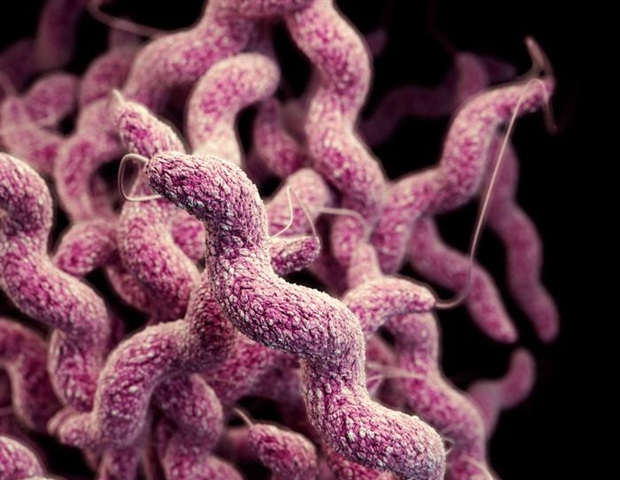
In 2019, the number of registered campylobacter infections increased by almost a fifth and studies show that many of the campylobacter outbreaks recorded that year were caused by chicken meat. These are some of the findings from the annual report on the incidence of zoonoses in Denmark for 2019.
Campylobacter has long been the bacteria that is to blame for the highest number of foodborne illnesses cases in Denmark. This trend continued in 2019 where 5,389 illness cases were registered. This is an 18.5% increase compared to the previous year and it is the third consecutive year that the number of campylobacter cases has increased.
This is one of the findings from the 2019 annual report on the incidence of zoonoses--disesases that can be transmitted from animals and food to humans. The report was prepared by the National Food Institute, Technical University of Denmark, in cooperation with Statens Serum Institut and the Danish Veterinary and Food Administration.
An increase in registered campylobacter outbreaks
The large increase in campylobacter cases is due to an unusually large outbreak related to Danish chicken meat. Chicken meat was also the source in five other outbreaks, while the source is unknown in three further outbreaks. The remaining campylobacter cases in 2019 are registered as sporadic--that is, they have no identifiable connection.
During 2019, Statens Serum Institut and the Danish Veterinary and Food Administration continuously analyzed and compared campylobacter from both patients and Danish chicken meat. Data show that campylobacter cases are more often related to outbreaks than previously thought, and as such the number of disease outbreaks related to campylobacter is higher than in previous years. According to the data, almost one third of all patients have a campylobacter infection that can be attributed to chicken meat.
"We are surprised that analyses of patient samples using whole genome sequencing show that the campylobacter cases to a greater extent are part of outbreaks, which can be traced back to the same food source, and that the majority of these outbreaks can be attributed to chicken. This knowledge provides new opportunities to prevent infection in Denmark," Head of Unit Eva Møller Nielsen at Statens Serum Institut says.
The large number of illness cases has led the industry to initiate a range of initiatives aimed at reducing the occurrence of campylobacter in the food production chain.
Focus on controlling campylobacter in Denmark and the EU
The importance of controlling campylobacter is also recognized at EU level, where an expert group under the European Food Safety Authority, EFSA, has assessed various options for controlling infection with the bacteria in the production of broilers. The results show that controlling campylobacter on farms is complicated and that no silver bullet exists.
Given that we in the expert group have not found one single solution to solve the problem, it is paramount that authorities, the industry and researchers have access to reliable data, which can guide efforts to reduce the incidence of illness in humans."
Johanne Ellis-Iversenm, Head of Research Group and Senior Advisor at the National Food Institute
Tick-borne diseases
Data from the annual report stress that it is wise to keep an eye out for ticks after a nature trip: According to a study from the University of Copenhagen of just over 1,000 ticks collected in Gribskov--a forest situated north of Copenhagen--approximately one in four ticks carry the disease borrelia, while one in five ticks carry at least two different zoonoses.
Research suggests that humans are at greater risk if they are bitten by a tick that has been infected with more than one zoonosis. Some of the infections, which an infected tick can cause weaken the human immune system making it easier for other zoonoses to establish themselves in the body.
The study from the University of Copenhagen underlines how important it is for doctors to consider whether a patient may have been infected with other diseases when the patient is diagnosed with and treated for an infection caused by a tick bite.
The annual report presents a large amount of data collected by authorities and the industry in Denmark on the incidence of zoonoses in feed, animals, food and humans. Many of the tables include datasets that span more than ten years and as such provide an opportunity to follow trends over time.
https://news.google.com/__i/rss/rd/articles/CBMieGh0dHBzOi8vd3d3Lm5ld3MtbWVkaWNhbC5uZXQvbmV3cy8yMDIwMDkwMy9DYW1weWxvYmFjdGVyLWluZmVjdGlvbnMtYW1vbmctRGFuZXMtaW5jcmVhc2VkLWJ5LWFsbW9zdC1hLWZpZnRoLWluLTIwMTkuYXNweNIBfGh0dHBzOi8vd3d3Lm5ld3MtbWVkaWNhbC5uZXQvYW1wL25ld3MvMjAyMDA5MDMvQ2FtcHlsb2JhY3Rlci1pbmZlY3Rpb25zLWFtb25nLURhbmVzLWluY3JlYXNlZC1ieS1hbG1vc3QtYS1maWZ0aC1pbi0yMDE5LmFzcHg?oc=5
2020-09-03 22:18:00Z
CAIiEOY8bWjvIONn8f7K6hctRZ4qMwgEKioIACIQZdRflS9INK7zM5FkBi3R3CoUCAoiEGXUX5UvSDSu8zORZAYt0dwwr47MBg
Bagikan Berita Ini














0 Response to "Campylobacter infections among Danes increased by almost a fifth in 2019 - News-Medical.Net"
Post a Comment